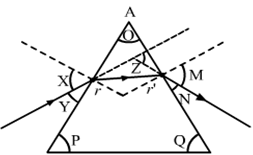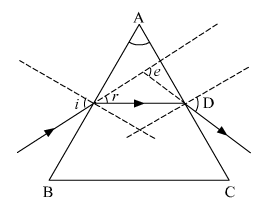The path of a ray of light passing through a glass prism is shown below:

In this diagram, the angle of prism, angle of incidence, angle of emergence and angle of deviation respectively have been represented by:
O, Y, Z and N
P, Y, M and Z
O, X, M and Z
O, X, M and Z
C.
O, X, M and Z
The correct option is C.
O is the angle of prism.
Angle of incidence is the angle made by the incident ray with the normal to the surface of the prism. Here, X represents the angle of incidence.
Angle of emergence is the angle made by the emerging ray with the normal to the surface of the prism. Here, M represents the angle of emergence.
Angle of deviation is the angle made by the emerging ray with the incident ray. Here, Z represents the angle of deviation.
Study the following figure in which a student has marked the angle of incidence (<i), angle of refrcation (< r), angle of emergence (< e), angle of prism ( < A) and the angle of deviation (<D). The corrected angles are: 




A.

the correctly marked angles as shown in the figure are: Angle of prism (A) and angle of incidence (e).
A student is observing a diagram showing the path of a ray of light passing through a glass prism. He would find that for all angles of incidence the ray of light bends:
Towards the normal while entering the prism and away from the normal while emerging from the prism.
Away from the normal while entering the prism and towards the normal while emerging from the prism.
Away from the normal while entering as well emerging from the prism.
Away from the normal while entering as well emerging from the prism.
A.
Towards the normal while entering the prism and away from the normal while emerging from the prism.
The correct option is A.
The ray of light travels from rarer to a denser medium as it enters a glass prism. Hence, ray of light bends towards the normal.
(a) List the parts of the human eye that control the amount of light entering into it.
Explain how they perform this function.
(b) Write the function of retina in human eye.
(c) Do you know that the corneal-impairment can be cured by replacing the defective cornea with the cornea of the donated eye? How and why should we organise groups to motivate the community members to donate their eyes after death?
a) The amount of light entering the eyes of a human is controlled by iris and pupil.
The iris automatically adjusts the size of the pupil according to the intensity of light received by the eye.
If the amount of light received by the eye is large (as during the daytime), then the iris contracts the pupil (makes the pupil small) and reduces the amount of light entering the eye. On the other hand, if the amount of light received by the eye is small (as in a dark room or during night), the iris expands the pupil (makes the pupil large) so that more light may enter the eyes. Thus, the iris regulates (or controls) the amount of light entering the eye by changing the size of the pupil.
b) The retina acts as a screen on which the image is formed in the eye.
The retina has a large number of light-sensitive cells called rods and cons. When the image falls on the retina then these light-sensitive cells get activated and generate electrical signals.
c) Yes.
There is a need for awareness among various communities about eye donation after death as it will help a person suffering from an eye ailment to get the treatment.
The following steps can be taken to organize groups to motivate them:
(i) The person who is taking the initiative can communicate with people and after realizing people who are like minded should gather them and form an awareness group.
(ii) The group should then approach various communities and organizations in their area and promote their campaign.
(iii) They can also approach various hospitals and clinics to promote the campaign.
